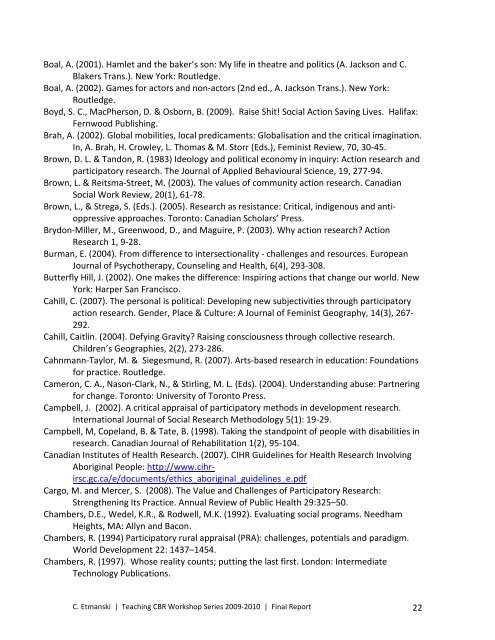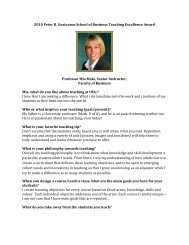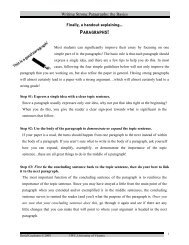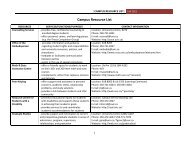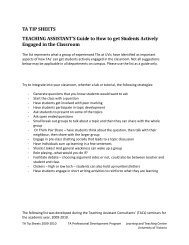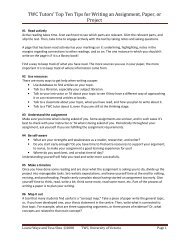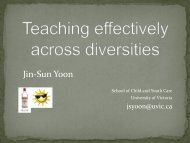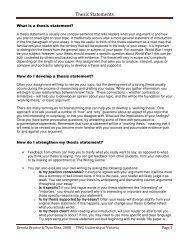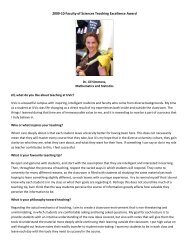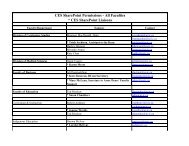Boal, A. (2001). Hamlet and the baker’s son: My life in theatre and politics (A. Jackson and C.Blakers Trans.). New York: Routledge.Boal, A. (2002). Games for actors and non-actors (2nd ed., A. Jackson Trans.). New York:Routledge.Boyd, S. C., MacPherson, D. & Osborn, B. (<strong>2009</strong>). Raise Shit! Social Action Saving Lives. Halifax:Fernwood Publishing.Brah, A. (2002). Global mobilities, local predicaments: Globalisation and the critical imagination.In, A. Brah, H. Crowley, L. Thomas & M. Storr (Eds.), Feminist Review, 70, 30-45.Brown, D. L. & Tandon, R. (1983) Ideology and political economy in inquiry: Action research andparticipatory research. The Journal of Applied Behavioural Science, 19, 277-94.Brown, L. & Reitsma-Street, M. (2003). The values of community action research. CanadianSocial Work Review, 20(1), 61-78.Brown, L., & Strega, S. (Eds.). (2005). Research as resistance: Critical, indigenous and antioppressiveapproaches. Toronto: Canadian Scholars’ Press.Brydon-Miller, M., Greenwood, D., and Maguire, P. (2003). Why action research? ActionResearch 1, 9-28.Burman, E. (2004). From difference to intersectionality - challenges and resources. EuropeanJournal of Psychotherapy, Counseling and Health, 6(4), 293-308.Butterfly Hill, J. (2002). One makes the difference: Inspiring actions that change our world. NewYork: Harper San Francisco.Cahill, C. (2007). The personal is political: Developing new subjectivities through participatoryaction research. Gender, Place & Culture: A Journal of Feminist Geography, 14(3), 267-292.Cahill, Caitlin. (2004). Defying Gravity? Raising consciousness through collective research.Children’s Geographies, 2(2), 273-286.Cahnmann-Taylor, M. & Siegesmund, R. (2007). Arts-based research in education: Foundationsfor practice. Routledge.Cameron, C. A., Nason-Clark, N., & Stirling, M. L. (Eds). (2004). Understanding abuse: Partneringfor change. Toronto: University of Toronto Press.Campbell, J. (2002). A critical appraisal of participatory methods in development research.International Journal of Social Research Methodology 5(1): 19-29.Campbell, M, Copeland, B. & Tate, B. (1998). Taking the standpoint of people with disabilities inresearch. Canadian Journal of Rehabilitation 1(2), 95-<strong>10</strong>4.Canadian Institutes of Health Research. (2007). CIHR Guidelines for Health Research InvolvingAboriginal People: http://www.cihrirsc.gc.ca/e/documents/ethics_aboriginal_guidelines_e.pdfCargo, M. and Mercer, S. (2008). The Value and Challenges of Participatory Research:Strengthening Its Practice. Annual Review of Public Health 29:325–50.Chambers, D.E., Wedel, K.R., & Rodwell, M.K. (1992). Evaluating social programs. NeedhamHeights, MA: Allyn and Bacon.Chambers, R. (1994) Participatory rural appraisal (PRA): challenges, potentials and paradigm.World Development 22: 1437–1454.Chambers, R. (1997). Whose reality counts; putting the last first. London: IntermediateTechnology Publications.C. <strong>Etmanski</strong> | <strong>Teaching</strong> <strong>CBR</strong> <strong>Workshop</strong> <strong>Series</strong> <strong>2009</strong>-20<strong>10</strong> | <strong>Final</strong> <strong>Report</strong> 22
Clover, D. & McGregor, C. (2008). Proceedings of the Third International Community UniversityExposition. (CU Expo 2008). University of Victoria: Victoria Canada.http://web.uvic.ca/ocbr/assets/pdfs/CUexpo2008_proceedings.pdfClover, D. E. & Markle, G. (2003). Feminist arts practices of popular education: Imagination,counter-narratives and activism on Vancouver Island and Gabriola Island. New ZealandJournal of Adult Education, 31(2), 36-52.Clover, D. E. & Stalker, J. (2005). Editorial: Social justice, arts and adult education. Convergence38 (4), 3-7.Clover, D. E. & Stalker, J. (Eds.) (2007). The arts and social justice: Re-crafting adult educationand community cultural leadership. Leicester, UK: NIACE.Clover, D. E. (2006). Out of the dark room: Participatory photography as a critical, imaginative,and public aesthetic practice of transformative education. Journal of TransformativeEducation, 4(3), 275-290.Clover, D. E., Follen, S. & Hall, B. (2000). The nature of transformation. Toronto, ON: OntarioInstitute for Studies in Education, University of Toronto.Cochran, P. A. L., Marshall, C. A., Garcia-Downing, C., Kendall, E., Cook, D., McCubbin, L., et al.(2008). Indigenous ways of knowing: Implications for participatory research andcommunity. American Journal of Public Health, 98(1), 22.Cole, P. (1998). An academic take on “indigenous traditions and ecology”. Canadian Journal ofEnvironmental Education, 3, <strong>10</strong>0-115.Community Economies Collective (2001). Imagining and enacting non capitalist futures. SocialistReview 28 (3 & 4), 93-135.Connor, D.M. (1988). A new ladder of citizen participation. National Civic Review, 77(3), 249-257.Conway, J. (2004). Identity, place, knowledge: Social movements contesting globalisation.Halifax: Fernwood Publishing.Cooke, B. & Kothari, U. (Eds). (2001). Participation: The new tyranny? London: Zed Books.Corbett, A. M. B. N., Francis, K., & Med, M. H. S. (2007). Feminist-informed participatory actionresearch: A methodology of choice for examining critical nursing issues. InternationalJournal of Nursing Practice, 13(2), 81.Cruikshank, B. (1999). The will to empower: Democratic citizens and other subjects. Ithaca &London: Cornell University Press.Davies, M. (2008). Raising the bar: Ethics review, governance, and accountability in communitybasedhuman health research. Sask.L.Rev., 71, 91.Dawson, T. & Keenan, L. (Eds.). (<strong>2009</strong>) Universal Instructional Design: Creating an AccessibleCurriculum at the University of Victoria. Victoria, BC: University of Victoria.Dawson, T. & Mateer, K. (<strong>2009</strong>). University of Victoria <strong>Teaching</strong> Assessment Guidelines:Assessment of teaching effectiveness and teaching excellence for decisions concerningreappointment, tenure and promotion. Victoria, BC: University of Victoria.Dawson, T. & Wall, M. (<strong>2009</strong>). Using the New Course Experience Survey to Assess and Improve<strong>Teaching</strong> at UVic. Background paper offering advice and guidance for Chairs and Deans.Victoria, BC: University of Victoria.Dawson, T. (2007). A Suggested Peer Review Process for <strong>Teaching</strong> Assessment. Victoria, BC:University of Victoria.C. <strong>Etmanski</strong> | <strong>Teaching</strong> <strong>CBR</strong> <strong>Workshop</strong> <strong>Series</strong> <strong>2009</strong>-20<strong>10</strong> | <strong>Final</strong> <strong>Report</strong> 23
- Page 2 and 3: Teaching Community Based ResearchRe
- Page 4 and 5: 2009 - 2010 Organizing Team (in Alp
- Page 6 and 7: Video DocumentationA local “Story
- Page 9: Evaluation and Ongoing EngagementWe
- Page 13: and make best use of the unique ski
- Page 16 and 17: Students Commission of Canada, a na
- Page 18 and 19: Developers Caucus and a member of t
- Page 20 and 21: Appendix B: Contents of Feedback Fo
- Page 24 and 25: De Silva, G.V.S., et al. (1979). Bh
- Page 26 and 27: Hall, B. (1993). Introduction. In:
- Page 28 and 29: Krumer-Nevo, M. (2009). From voice
- Page 30 and 31: Pain, R. (2004) Social geography: p
- Page 32 and 33: Shore, N., Wong, K. A., Seifer, S.


